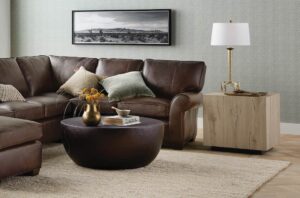In today’s dynamic home furnishing market, the choice between Club Furniture vs Pottery Barn can significantly impact your living space.
Both brands, each with their unique styles and offerings, cater to a wide array of tastes and preferences.
This article delves into the intricacies of both, shedding light on their respective strengths and differences.
Understanding this comparison is crucial for potential buyers, as it guides them in making an informed decision to enhance their home’s comfort and aesthetic appeal.
Quick Compare
| Feature | Club Furniture | Pottery Barn |
|---|---|---|
| Quality | Higher-end, top grain leather, kiln-dried hardwoods, hand-tailored upholstery | Decent quality, sturdy construction but not top-tier |
| Price Range | $999 to $3499 (mid to high) | $799 to $2999 (generally lower) |
| Style | Casual contemporary, transitional, sleek, modern | Coastal, farmhouse, traditional, relaxed, breezy aesthetic |
| Selection | Living room, dining room, bedroom furniture and accessories | Broader range including furniture, decor, lighting, bedding, kitchenware |
| Brand Reputation | Known for outstanding quality and service, fewer complaints | Mixed reviews, some inconsistencies in quality and service |
| Customization | More options with various fabrics, leathers, finishes | Less customization flexibility |
| Retail Presence | Primarily online, some showrooms | Online and catalog sales, limited retail stores |
| Warranty & Guarantee | Extensive warranties, including a buy-it-back policy and guarantees on materials and craftsmanship | Standard one-year warranty, lifetime warranty on many products, 30-day satisfaction guarantee |
Overview of Club Furniture
Club Furniture stands as a testament to quality and craftsmanship in the furniture industry.
Here, we delve into what makes this brand a preferred choice for discerning homeowners.
History and founding of Club Furniture
Founded in 1983, Club Furniture emerged from a desire to offer high-quality, comfortable, and stylish furniture.
The brand quickly established itself as a reliable source of finely crafted furniture, combining traditional workmanship with modern design principles.
Unique selling points of Club Furniture
What sets Club Furniture apart?
It’s their commitment to superior quality. They use top grain leather and kiln-dried hardwoods, ensuring durability and longevity.
Additionally, their hand-tailored upholstery is a mark of their dedication to detail. This meticulous approach to furniture making not only promises longevity but also a timeless elegance in every piece.
Range of products offered
Club Furniture boasts an impressive array of products:
- Living Room: Sofas, chairs, sectionals, and ottomans.
- Dining Room: A variety of tables, chairs, and storage options.
- Bedroom: Beds, dressers, and nightstands that blend functionality with style.
This diverse selection caters to different tastes and needs, making Club Furniture a one-stop shop for many homeowners.
Customer perception and market reputation
Customers often praise Club Furniture for its outstanding quality and service. The brand has fewer complaints compared to others in the market, indicating a high level of customer satisfaction.
Their reputation is built on the foundation of trust and reliability, making them a favored choice among those who value quality and craftsmanship in their furniture.
Note: Club Furniture’s approach to combining traditional craftsmanship with modern design has not only won them a loyal customer base but also set a benchmark in the furniture industry.
In sum, Club Furniture’s history, unique selling points, diverse product range, and strong customer perception highlight why it is a significant player in the home furnishing market.
Their commitment to quality and service makes them a brand worth considering for anyone looking to enhance their home with furniture that is both stylish and durable.
Overview of Pottery Barn
Pottery Barn represents a blend of comfort and style, appealing to a broad customer base.
This section explores the brand’s journey, its unique offerings, and how it stands in the eyes of its customers.
Background and evolution of Pottery Barn
Established in 1949, Pottery Barn began as a small company and has grown into a renowned home furnishing brand.
Part of the Williams-Sonoma family, it has evolved over the decades, consistently adapting to changing home decor trends while maintaining its core values of quality and customer service.
Distinctive features and styling of Pottery Barn
Pottery Barn’s styling stands out for its:
- Coastal Theme: Offering a relaxed, breezy aesthetic.
- Farmhouse Design: Rustic yet refined furniture pieces.
- Traditional Elements: Classic styles that never fade.
These features have made Pottery Barn synonymous with comfort and sophistication, appealing to a wide range of tastes.
Product diversity and availability
Pottery Barn offers an extensive range of products, covering almost every aspect of home furnishing:
- Furniture: Sofas, beds, tables, and more.
- Decor: From wall art to throw pillows.
- Lighting: Elegant solutions for every room.
- Bedding and Kitchenware: Essentials for a comfortable home.
This wide selection allows customers to furnish their entire home under one brand, making Pottery Barn a convenient choice for many.
Brand image and consumer feedback
Pottery Barn’s brand image is characterized by its broad product range and approachable pricing. However, it has received mixed reviews, with some customers noting inconsistencies in quality and service.
While some praise the brand’s style and variety, others have raised concerns about occasional product damages and service issues.
Note: Pottery Barn’s extensive range and approachable pricing have made it a popular choice, but it’s essential to consider the mixed customer feedback when making a purchase decision.
Pottery Barn stands as a major player in the home furnishing industry, known for its diverse product range and distinct styling.
While its broad appeal is evident, potential buyers should weigh the mixed customer feedback as part of their decision-making process.
Key Comparison Between Club Furniture and Pottery Barn
When deciding between Club Furniture vs Pottery Barn, various factors come into play, each significant in its own right.
This comparison aims to provide a clearer picture for those torn between these two brands.
Comparison of Quality and Materials Used
- Club Furniture is renowned for its higher-end materials, such as top-grain leather and kiln-dried hardwoods. The hand-tailored upholstery is a testament to their commitment to quality.
- Pottery Barn, on the other hand, offers decent quality materials with sturdy construction, though not as high-end as Club Furniture.
Price Range and Value for Money
- Club Furniture’s sofas range from $999 to $3499, placing them in the mid to high price bracket, reflective of their premium materials.
- Pottery Barn provides a more affordable range, with sofas priced from $799 to $2999.
Style and Design Preferences
- Club Furniture specializes in casual contemporary and transitional styles, featuring sleek and modern silhouettes.
- Pottery Barn leans towards coastal, farmhouse, and traditional styling, giving off a relaxed and breezy aesthetic.
Selection and Variety in Product Offerings
- Club Furniture offers a curated selection for the living room, dining room, and bedroom.
- Pottery Barn boasts a broader range, extending to furniture, decor, lighting, bedding, and kitchenware.
Customization Options and Flexibility
- Club Furniture outshines with more customization options, offering various fabrics, leathers, and finishes.
- Pottery Barn is less flexible in customization, offering standard options in line with their style categories.
Retail Presence and Customer Accessibility
- Club Furniture operates primarily online, supplemented by some showrooms.
- Pottery Barn combines online and catalog sales with a limited number of retail stores.
Note: This comparison highlights the unique attributes and differences between Club Furniture and Pottery Barn, aiming to assist buyers in aligning their choices with personal preferences and needs.
Each brand has its strengths, from the quality and variety of materials to style preferences and price points.
Understanding these differences is key in making an informed choice that aligns with individual needs and style preferences.
Which Brand Suits You Better?
Choosing between Club Furniture and Pottery Barn hinges on several personal factors.
This segment helps you weigh your options based on various criteria.
Analyzing needs: Quality vs. Budget
When selecting furniture, balance is key. If you prioritize enduring quality and can allocate a higher budget, Club Furniture, with its top-tier materials and hand-tailored upholstery, might be your match.
On the other hand, if you seek good quality within a more modest budget, Pottery Barn’s offerings provide sturdy construction at lower price points.
Matching style preferences with brand offerings
Your style preference is a crucial deciding factor. If your home resonates with a modern and sleek aesthetic, Club Furniture’s contemporary and transitional styles will suit you.
Conversely, if you’re drawn to a more relaxed, coastal, or farmhouse vibe, Pottery Barn’s traditional and breezy styling will align with your taste.
Considering the importance of customization and selection
The extent of customization and variety you desire can significantly influence your choice.
Club Furniture offers a broader range of customization options, allowing you to tailor your furniture to specific preferences.
Pottery Barn, while offering less customization, provides a wider selection of products, covering not just furniture but also decor, lighting, and kitchenware.
Evaluating brand reputation and customer service
Brand reputation and customer service are vital.
Club Furniture boasts fewer complaints and is known for excellent service and quality. Pottery Barn, with its larger scale, has a mixed reputation, with some inconsistency in service and quality.
Note: Reflect on what matters most to you – be it the quality of materials, style, customization options, or the brand’s reputation and customer service. Your decision should align with your individual needs and preferences.
In essence, the choice between Club Furniture vs Pottery Barn boils down to your personal priorities in quality, style, customization, and overall brand experience.
Consider these factors carefully to make a choice that best fits your home and lifestyle.
Conclusion and Final Thoughts
In summing up the Club Furniture vs Pottery Barn debate, we see clear distinctions in quality, style, and pricing.
Club Furniture excels with its high-quality materials and custom options, ideal for those who prioritize craftsmanship. Pottery Barn, with its diverse range and approachable prices, caters to those seeking style and variety.
Ultimately, the choice depends on individual preferences and lifestyle needs. As the furniture market continues to evolve, making an informed decision becomes paramount.
We hope this comparison aids you in selecting a brand that not only suits your home but also enriches your living experience.





